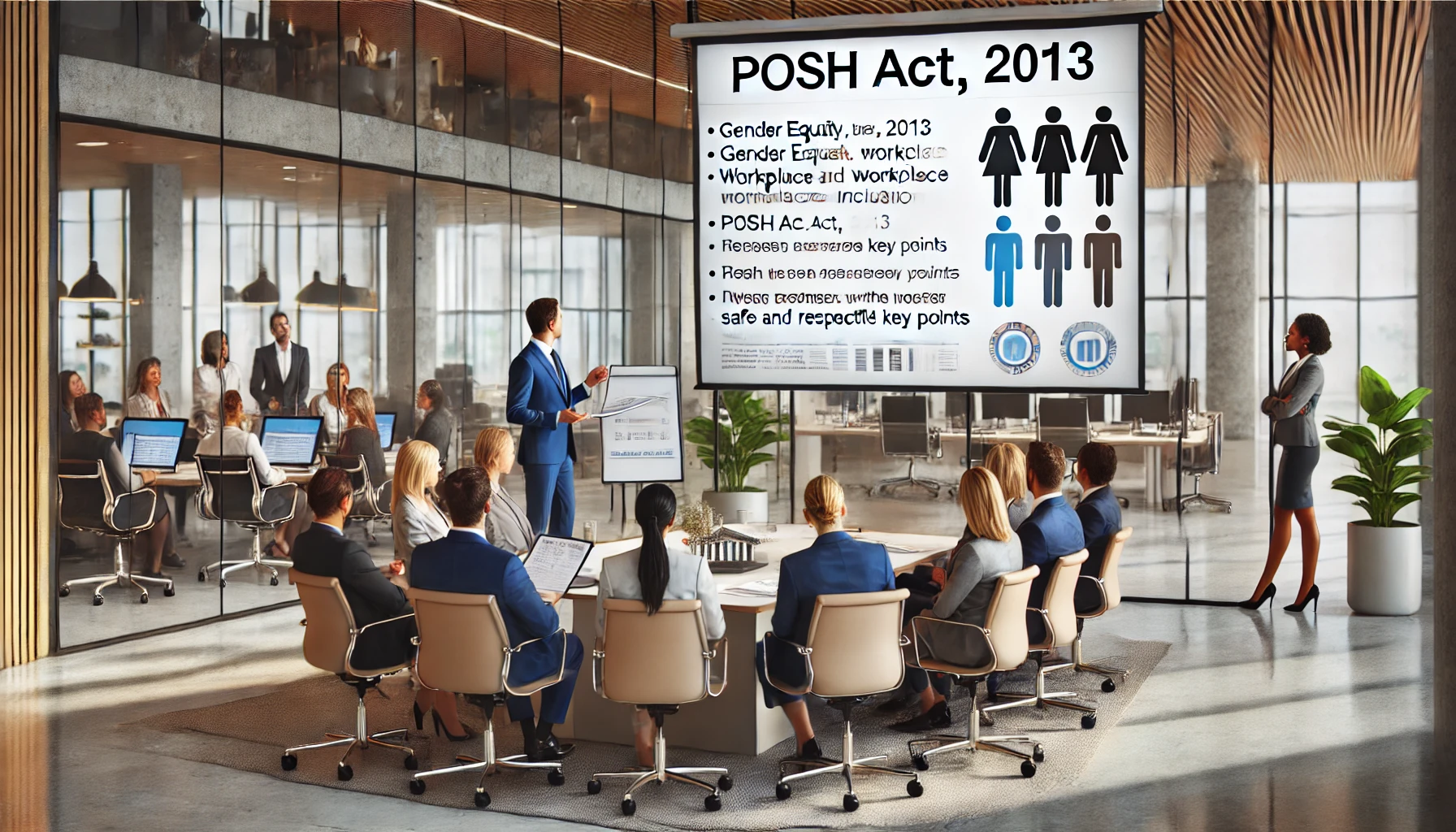- 10
- 02-2025
Category : Organizational Behavior and Culture
Comprehensive Tutorial On Gender Equity, Inclusion & Posh Act, 2013
By : Dinesh KumarThis tutorial provides a step-by-step learning guide on gender equity, workplace inclusion, and the Prevention of Sexual Harassment (POSH) Act, 2013. It covers legal provisions, redressal mechanisms.
Gender Equity Posh
Module 1: Gender Equity and Inclusion
1.1 Understanding Gender and Its Social Construction
✅ Definition of Gender
- Gender refers to the social and cultural roles, behaviors, and expectations assigned to individuals based on their sex.
- It differs from biological sex, which is based on physical characteristics.
✅ How Gender is Socially Constructed
- Society assigns specific expectations to men, women, and non-binary individuals.
- Examples:
- Men are expected to be strong and leaders.
- Women are expected to be caregivers.
- Non-binary individuals often face exclusion.
- Men are expected to be strong and leaders.
- Women are expected to be caregivers.
- Non-binary individuals often face exclusion.
1.2 Unconscious Bias and Stereotypes
✅ What is Unconscious Bias?
- Hidden prejudices we hold without realizing.
- Example: Assuming men are better at leadership roles.
✅ Gender Stereotypes in the Workplace
- Women are emotional and not suited for leadership.
- Men are aggressive and natural decision-makers.
- These biases impact hiring, promotions, and work culture.
1.3 Gender-Based Discrimination and Bias
✅ Forms of Workplace Discrimination
- Unequal pay
- Fewer leadership opportunities for women
- Sexual harassment
✅ Legal Protections Against Gender Discrimination
- POSH Act, 2013 – Protects against sexual harassment.
- Equal Pay Act, 1976 – Ensures equal wages for men and women.
1.4 Inclusivity and Diversity in Workplaces
✅ What is an Inclusive Workplace?
- A workplace where all genders have equal opportunities.
- Safe, respectful, and free from discrimination.
✅ How to Promote Inclusion?
- Gender-neutral policies
- Equal pay and opportunities
- Awareness training on gender sensitivity
Module 2: Genesis of POSH Act, 2013
2.1 International Conventions on Sexual Harassment Prevention
- CEDAW (Convention on the Elimination of All Forms of Discrimination Against Women) – A global treaty supporting gender equality.
- ILO Guidelines – International Labor Organization's framework for preventing harassment.
2.2 Indian Legal System Before POSH
Before the POSH Act, there were no structured complaint mechanisms in workplaces. Women had to rely on:
- IPC Section 354 (assault on a woman with intent to outrage her modesty).
- IPC Section 509 (word, gesture, or act intended to insult a woman).
2.3 Vishakha Guidelines (1997)
- Introduced after the Vishakha vs. State of Rajasthan case.
- Defined sexual harassment at workplaces and employer responsibilities.
- Served as the basis for the POSH Act, 2013.
2.4 Evolution of the POSH Act, 2013
- Aimed to create structured guidelines for preventing workplace harassment.
- Mandated the Internal Complaints Committee (IC) for organizations.
Module 3: Key Features of POSH Act, 2013
3.1 Important Definitions
- Workplace: Includes offices, remote workspaces, and even virtual workplaces.
- Aggrieved Woman: Any woman facing harassment in the workplace.
3.2 What is Sexual Harassment?
Defined as unwelcome:
- Physical contact
- Sexual advances
- Inappropriate remarks
- Explicit messages or emails
3.3 Types of Sexual Harassment
- Quid Pro Quo: Harassment in exchange for work benefits (e.g., promotions).
- Hostile Work Environment: Creating an intimidating, offensive, or discriminatory workspace.
3.4 What is NOT Sexual Harassment?
- Constructive feedback
- Workplace jokes that are not offensive
- Professional interactions
Module 4: Prevention & Prohibition Under POSH Act, 2013
4.1 Who is an Employer Under POSH?
- Any person responsible for the workplace, including CEOs, HR managers, and business owners.
4.2 Employer’s Responsibilities
✅ Develop and implement an anti-harassment policy
✅ Conduct POSH awareness training for employees
✅ Ensure a clear redressal mechanism
4.3 Internal Complaints Committee (IC) and Its Role
Who forms the IC?
- Minimum 4 members
- External member (NGO or legal expert)
Functions of IC:
✅ Investigate complaints
✅ Conduct hearings
✅ Recommend disciplinary actions
Who forms the IC?
- Minimum 4 members
- External member (NGO or legal expert)
Functions of IC:
✅ Investigate complaints
✅ Conduct hearings
✅ Recommend disciplinary actions
4.4 Local Complaints Committee (LC)
- Established for organizations with fewer than 10 employees.
Module 5: Redressal and Monitoring Mechanism
5.1 Who Can File a Complaint?
- Any woman employee, consultant, or intern.
5.2 Rights of Complainant & Respondent
✅ Fair hearing
✅ Confidentiality
5.3 Complaint Redressal Steps
1️⃣ Complaint must be filed within 3 months of the incident.
2️⃣ IC investigates and conducts hearings.
3️⃣ Appropriate disciplinary action is recommended.
5.4 Confidentiality Rules
- Names of complainant and respondent cannot be disclosed publicly.
Module 6: Building Organizational Capability for POSH Compliance
✅ Awareness training sessions for employees.
✅ Drafting a POSH policy and sharing it with employees.
✅ Regular compliance reporting to authorities.
✅ HR’s role in training and implementation.
Module 7: Effective Presentation Skills
7.1 Understanding Your Audience
- Analyze their background and knowledge level.
7.2 Creating Engaging Content
- Use real-life case studies and statistics.
- Keep slides simple and visual-based.
7.3 Delivery Techniques
- Maintain eye contact and positive body language.
- Speak clearly and confidently.
Module 8: Audience Interaction & Engagement
8.1 How to Engage the Audience?
✅ Ask open-ended questions
✅ Encourage participation
✅ Use storytelling techniques
8.2 Visual Aids for Presentations
- Infographics, images, and videos improve understanding.
8.3 Handling Difficult Questions
- Stay calm and professional.
- Redirect irrelevant questions without confrontation.
Conclusion
This tutorial equips learners with the knowledge to:
✅ Understand gender equity and workplace inclusion.
✅ Implement POSH Act compliance in organizations.
✅ Develop effective training and presentation skills.
Would you like a PowerPoint presentation or training videos based on this tutorial? 😊
